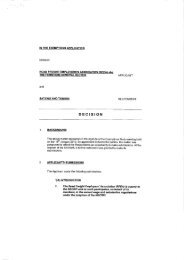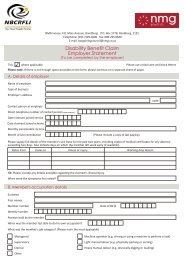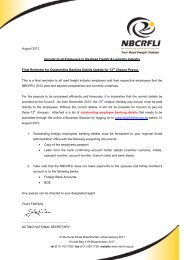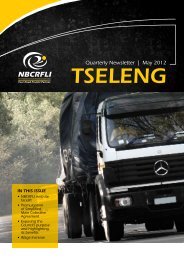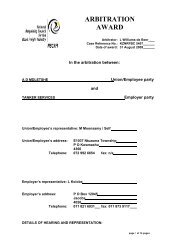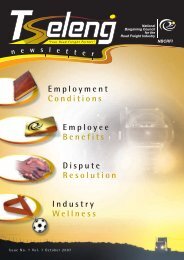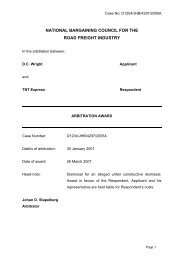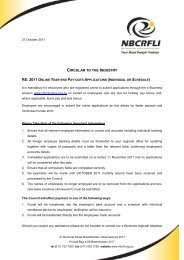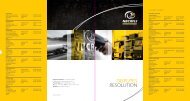Jacky Seanego vs SBV - 20 Dec 2007 - nbcrfli.org.za
Jacky Seanego vs SBV - 20 Dec 2007 - nbcrfli.org.za
Jacky Seanego vs SBV - 20 Dec 2007 - nbcrfli.org.za
You also want an ePaper? Increase the reach of your titles
YUMPU automatically turns print PDFs into web optimized ePapers that Google loves.
IN THE NATIONAL BARGAINING COUNCIL FORTHE ROAD FREIGHT INDUSTRYIN THE MATTER BETWEEN:<strong>Jacky</strong> <strong>Seanego</strong>447 Mosikile SectionKatlehongC/o Bregman Mitchley AttorneysFax: (086) 680 9142ApplicantAnd<strong>SBV</strong> Services1 Scott StreetWaverley<strong>20</strong>90Fax: (011) 386 2<strong>20</strong>1RespondentAWARDCASE NUMBER:D126/JHB/0000/07Date/s of arbitration: 25 September <strong>20</strong>07Date of award 01 October <strong>20</strong>07Head-note: Dismissal for misconduct- Supplying false information on theemployment application form-Application dismissed1. DETAILS OF THE HEARING AND REPRESENTATIONThe dispute is an alleged unfair dismissal referred to the Council for arbitration in termsof section 191(1) (a) (i) of the LRA 66 of 1995(as amended and herein referred to as “theAct”). The arbitration heard was held on 25 September <strong>20</strong>07at the offices of theNational Bargaining Council for the Road Freight Industry in Johannesburg.Both parties were present. Representing the Respondent party, <strong>SBV</strong> Services (Pty) Ltdwas Mr. Komane; it’s IR Officer and herein referred to as “the Respondent”. The1
Applicant, Mr. <strong>Seanego</strong>, was represented by Mr. Bregman, a legal practitioner andherein referred to as “the Applicant”.The hearing was mechanically recorded and the services of an interpreter, Mr. Baloyi,were also utilized.ISSUES TO BE DECIDEDWhether the Respondent dismissal of the Applicant was both procedurally andsubstantively fair. Should the finding be that the Applicant was dismissed unfairly, I mustdetermine the remedy in terms of the LRA, 66 of 1995, as amended. (“the Act”)2. BACKGROUND TO THE ISSUEAn unfair dismissal dispute was initially referred to the Council. No settlement could bereached and a certificate of non-resolution was issued. The matter was then scheduledfor arbitration.The Applicant was employed as a Protection Officer and was dismissed following adisciplinary hearing and after being found guilty of supplying false information in hisapplication for employment. The Applicant on the other hand, stated that he was notguilty as he did not supply false information in his application for employment.Respondent and the Applicant tendered the same bundle of documents. Both partiesaccepted that the documents are what they purport to be. The parties agreed that theRespondent would begin presenting its evidence. Furthermore, both parties handed intheir written closing arguments subsequent to the arbitration proceedings and must beduly noted. The said arguments are referred to as the Applicant’s closing and theRespondent’s respectively.The Applicant seeks either reinstatement or compensation as envisaged by the Act.Before the commencement of the arbitration hearing, a party held a pre-arb conferenceand herewith is a brief synopsis of what was stated;Common Cause;• The Applicant was employed as a Protection Officer on 14 <strong>Dec</strong>ember <strong>20</strong>06.• He was dismissed on 5 January <strong>20</strong>07.• He was earning a salary of R3925-00 at the time of his dismissal.• He was dismissed after being found guilty of supplying false information.• There was a disciplinary hearing held on 4 January <strong>20</strong>07.• The Applicant attended and by choice, was not represented.• He was suspended.• The hearing was chaired by De Vries.• The Applicant appealed the chair’s decision and such was held on 26 January<strong>20</strong>07.• The procedural merits are not placed in dispute.Issues in Dispute;2
• Whether the Applicant was dismissed for misconduct from Coin Security group.• Whether failing a polygraph test constitute misconduct or a dismissible offence.3. SURVEY OF EVIDENCE AND ARGUMENTRespondent’s evidence:Mr Joubert (“Joubert”)CIT Manager-Midrand DivisionUnder oath and in his evidence in chief, Joubert testified that he is the Respondent’smanager situated at the Midrand branch. The Respondent’s main clients are four majorbanks to which he is responsible for in terms of cash processing and replenishmentthereof.The Applicant was stationed at the East Rand division and was dismissed for notdeclaring that he was previously dismissed by Coin Security Group. Joubert knew thisas he was informed by Mr Shipton (“Shipton”), one of the managers, who received suchinformation from one William, a Coin Security manager, stating that the Applicant wasdismissed from their services. The purpose of the call was made to the Respondentafter William saw the Applicant in the Respondent’s uniform. William then notified theRespondent that the Applicant was dismissed. Joubert requested this information inwriting as he was not aware that the Applicant was in fact dismissed from his previousemployer, Coin Security. He received the requested information. ( page 50 of thebundle). The said letter stated that; verbatimPlease be advised that you were dismissed on the 1 stFebruary <strong>20</strong>06 for the following reasons;You failed polygraphy (sic) test for the theft/money shortage where u madethe pick up as a Crewman on the 27/12/<strong>20</strong>05.Upon receipt of the letter mentioned supra, he noted that the Applicant did not declarethat he was dismissed by Coin Security. The Applicant had stated that he wassuspended at Coin Security (page 11 of the bundle)The Applicant was subsequently suspended pending the outcome of the investigations.The investigations entailed retrieving the Applicant’s file from Coin Security andinterviewing Ms Myeko, the HR manager responsible for managing the application formsreceived from potential candidates who were filing the application forms. During theinterview with Myeko, she indicated that she answered all questions asked by all theparticipants/candidates. She explained the contents of the application forms and invitedquestions from the candidates. He also spoke to the Applicant afterwards.Regarding the Respondent’s application for employment forms under the heading, ‘Haveyou been dismissed for misconduct at a previous employer?” the Applicantindicated “no”. According to the Respondent’s code contained in page 31of the bundle,par 10.11, the Applicant deliberately breached the code.3
Joubert further testified that he got along well with the Applicant during his short-livedemployment relationship.This concluded Joubert’s testimony.During cross-examination, Joubert was asked if the Applicant was dismissed or whetherhe was dismissed ‘for failing a polygraph test’ by Coin Security. His response was thatthe Applicant was dismissed for failing a polygraph test.Joubert was further asked if he agreed that it was not clear why the Applicant wasdismissed by Coin to which he stated that it was a fact that the Applicant was dismissedand that he did not indicate that in his application forms. The Applicant stated thathaving said “no” was in response to a question asked –‘have you ever beendismissed’.It was at then put to the Respondent that it should ‘change their application form’ as itmisleads, that the Applicant was dismissed for misconduct. The Applicant only stated nobecause he comprehended the question to mean ‘no’, “I have not been dismissed formisconduct”. In response to this, Joubert stated that the dismissal came about due tothe Applicant ‘not keeping up with the terms and conditions of his suspension’ (page 11of the bundle).Respondent’s 2 nd WitnessMs Myeko (herein referred to as “Myeko”)HR Officer- Coin Security GroupIn her evidence given under oath, Myeko testified that;She is Human Resources Officer for the Coin Security Group and invigilated thecandidates for employment on the day in question. The Applicant was one of thecandidates. She explained the contents of the application forms for the Applicant. Shefurther explained the implications of not telling the truth, that should it be discovered thathe did not tell the truth, he will be immediately dismissed and escorted off the premises.The Applicant had to elaborate his statement in page 21 of the bundle if the answer wasa ‘yes’. She had explained this to the Applicant.Upon completing the forms, the Applicant declared that he had stated the truth in all thereplies he provided. The Applicant signed the declaration.During cross-examination, Myeko stated that the forms were completed at an openspace at the Respondent’s place and that about 30 candidates participated. Beforegiving out the application forms, she explained everything upfront to indicate if claritymay be sought.She further confirmed that several candidates did ask questions of clarity. She deniesthat the Applicant raised his concern regarding the question asked and that if theApplicant had indicated that he was dismissed, she could have asked him to leave thepremises immediately.During re-examination, new evidence brought was why <strong>SBV</strong> (Respondent) wasintolerable of false information given; the response was that being a security industry4
dealing with cash, honesty plays an important part. I then gave the other side anopportunity to cross-examine on the new evidence. The response was that theApplicant was not dismissed for misconduct and that he was honest in the completion ofthe forms.This concluded Joubert’s evidence.The Applicant’s versionMr. <strong>Seanego</strong> (“the Applicant”)In his evidence given under oath, the Applicant testified to the following:He was employed by the Respondent as a Protection Officer. He had good relationshipwith his manager during his employment relationship. Coin had a grudge against him forinformation he does not intend disclosing, hence it called <strong>SBV</strong> for ‘whatever reasons’ sothat his services can be terminated.Coin Security Group dismissed him for failing a polygraph test. He was not criminallycharged. He did not deliberately supply false information. The question asked stated“have you been dismissed”, he said ‘no’ because he was not dismissed for misconduct.He asked questions from Myeko and wanted to know how the forms should becompleted. Almost 30 people participated. It took a while for the forms to be completed,it was ‘a whole day affair and the lady (Myeko) was in a hurry’.Being in a hurry, Myeko just said ‘cross and refer to CV’. He did likewise. He believesthat he should have been told if he was to indicate that he was dismissed.During cross-examination, the Applicant confirmed that he matriculated and that hecould read and write. Asked why he supplied false information in relation to the fact thathe was dismissed, his response was that he did not, that he supplied the truth.Asked why he did not disclose that he was dismissed for failing a polygraph test, theApplicant response was “I said there was no space. If I said ‘yes’, I would not havesupplied correct information, I was dismissed but not for misconduct.” He does notbelieve that failing a polygraph test is another form of misconduct, furthermore, he hadother issues with Coin that he does not wish to disclose’.Asked why he did not refer those ‘issues’ to the CCMA, the Applicant stated that he didnot want to work for Coin anymore. Asked whether he was dismissed for failing apolygraph test or for failing to comply with his suspension conditions, the Applicantstated that he was dismissed for failing a polygraph test. The Applicant furtherconfirmed the suspension from Coin.It was put to the Applicant that he failed to challenge his allegation at the disciplinaryenquiry to which he stated that he said ‘everything he could remember’, furthermore, hedid the best he could and that he was not represented. Asked why he did not challengeJoubert’s evidence, the Applicant stated that he did not work with Joubert but withanother manager.ANALYSIS OF EVIDENCE AND ARGUMENT5
Cases of misconduct entitles an employer to dismiss an employee unless the employercannot prove that there was justification for the dismissal of the employee [see section188 (1) (a) (i) of the Labour Relations Act 66 of 1995 and item 3 (4) of schedule 8 on theCode of Good Practise.Before the commencement of these arbitration proceedings, parties held yet anotherpre-arbitration conference to narrow down issues. Much was said about how theApplicant’s employment relationship with his former employer was terminated. I amhowever, not required to determine how that relationship came to an end as the issue indispute is not between the Applicant and his former employer but between the Applicantand his present employer and to determine whether the Applicant’s dismissal wassubstantively fair or not.Parties held a debate about whether the Applicant was dismissed for misconduct or not.The Respondent stated that the Applicant was dismissed for “supplying false informationin your application form”. The wording of the application form read;Have you ever been dismissed for misconduct at a previous employer?‘yes’ or ‘no’. If yes, kindly provide details.This statement does not need a rocket scientist to determine what the intention of theRespondent was. The statutory definition of dismissal is set out in section 186 (1) of theAct which reads that a dismissal means;(a) an employer terminated a contract of employment with or withoutnotice;(b) an employee reasonably expected the employer to renew a affixedtermcontract of employment on the same or similar terms but theemployer offered to renew it on less favorable terms, or did not renewit’(c) an employer refused to allow an employee to resume work after she(i) took maternity leave in terms of any law, collective agreement orher contract of employment;(d) an employer who dismissed a number of employees for the same orsimilar reasons has offered to re-employ one or more of them but hasrefused to re-employ another; or6
(e) an employee terminated a contract of employment with or withoutnotice because the employer made continued employment intolerablefor the employee;an employee terminated a contract of employment with or without notice becausethe employer, after a transfer in terms f section 197 or 197A, provided theemployee with conditions of service that are substantially less favorable to theemployee than those provided by the old employer.From this section, it is clear that of importance is that the contract of employment hasbeen terminated- and for various reasons. It would be vague and senseless for theRespondent to just state: “Have you been dismissed” without stating the reasonsthereof. What the question needs to achieve should clearly be noted. As mentionedabove, a dismissal can be for various reasons, from being initiated by an employer tobeing initiated by an employeeThis question is not unique. It is prevalent in most application forms. It seeks to solicitinformation relating to the previous dealings be itemployment/banks/business/educational etc history. Where more information isneeded, the applicant will be asked to elaborate or explain. An example of this is whereone would be required to fill in the forms that says, have you been married, if so how;1. In community of property-1. Out of community of property-3. Common law.Stating that one is married without explaining how will yield no desired fruits. Thisquestion was not unique to the Applicant either. , The same line of questioning wasused in page 13 of the Respondent’s bundle. The question reads ‘Do you have anydependents?” The Applicant said ‘yes’, furthermore, the question goes on to say “Ifyes, kindly indicate their names and ages below”. The Applicant stated the name. Ifail to see how the Applicant ‘understood’ the question and managed to answer it withoutany hassles. This answer emanated from the question previously asked which said “Ifyou are married or are in a long term relationship, state full names of partner. Towdifferent surnames appear. The Applicant is <strong>Seanego</strong> whereas the partner is Ramaoka.The question did not confuse the Applicant. The Applicant did not mention whether hewas married or in a long-term relationship but managed to elaborate further. I fail to seewhy the same was not done with the question in dispute; save to say that there was areason why the Applicant chose not to elaborate. The latter question was not prejudicial7
in any manner whatsoever, whereas the other, the Applicant stood to lose his job if heelaborated. That is the reason. Furthermore, this version is corroborated by Myeko’sevidence that should the Applicant have answered ‘yes’, he could have been told toleave immediately. The Applicant took his chance and deliberately answered ‘no’ andhoped for the best.Myeko testified that ‘several candidates asked questions’. Myeko denied that theApplicant asked him a question. She further testified that if the Applicant had stated thathe was dismissed, she could have asked him to leave. The Applicant did not refutethese allegations. In the premise, Myeko’s evidence must succeed.The question was aimed at soliciting information regarding previous employmentrelationship and the Applicant knew that should it be found out that he was ‘dismissed’,‘he would be told to leave immediately’, as per Myeko’s testimony. The Applicant tookhis ‘chance’ and kept silent as he knew the results thereof. I draw this inference not onlyfrom the prejudice point of view but also from his own evasive testimony as well,including his dubious testimony regarding why he did not challenge his dismissal withthe CCMA. From his evidence, the only question ever posed to Myeko was that aboutinformation regarding his CV. He was then told to write ‘refer to CV’. The Applicant didnot ask a question relating to how he should answer that question.The Applicant withheld the information required as it could have prejudiced his chance ofever being employed. The Applicant understood the question and did not seek anyquestion of clarity in this regard because there was no reason to ask a question as thequestion was very clear, only prejudicial for him.It is therefore my view that the Applicant knew and understood the question. TheApplicant might have asked Myeko some questions of clarity but not on this subject.The Applicant stated that he said ‘no’ because he was not dismissed for misconduct. Ifthe Applicant’s intentions were as good as he’d like everyone to believe, what stoppedhim from writing the same argument, ‘no’, I was dismissed but not for misconduct’ or‘yes,’ I was dismissed but not for misconduct’. Elaborate if the intentions were good.8
There is nothing ambiguous about the question and even if it was, there was Myeko toexplain. The Applicant was asked why he did not challenge his dismissal with Coin if hebelieved that it was unfair. His response was that he did not want to work with Coinanymore. It is not like he had a choice.The Applicant stated that he was dismissed for failing a polygraph test and not for hissuspension which he did not want to elaborate on. Firstly whether the Applicant wasdismissed for polygraph or suspension is of no consequence for this matter, the fact ofthe matter is that the Applicant failed to indicate that such a dismissal took placefurthermore, why. The Applicant deliberately withheld this information.Regarding polygraph, my duty is to determine if there was a dismissal as envisaged insection 191(1) (a) of the Act and as referred by the Applicant. The distinguishingcharacteristic of workplace misconduct is that the employees concerned wereresponsible for their actions. In this respect, dismissals for misconduct aredistinguishable form dismissals for incapacity or dismissal for the operationalrequirements. The key word here is ‘dismissal’. What informed such a dismissal issecondary.Misconduct is the most common justification for dismissal in our country, yet nocomprehensive legal definition of the term is to be found in our statute or case law.Misconduct can take many and varied forms. However, the legal basis for dismissal formisconduct is the same in all cases; the employees concerned are deemed to havecommitted a breach of a material term of their contract or destroyed the employmentrelationship, which justifies termination of the employment relationship.In labour law, misconduct is said to take place when an employee culpably disregardsthe rules of the workplace. The evidence in casu claims that the Applicant wasdismissed for failing a polygraph testing. This means that there was a repudiation of acontract of employment which resulted in a dismissed. The dismissal took place ‘as aresult of’.It is not so much as to why the Applicant failed a polygraph test or disobeyed hissuspension condition, it is the ‘actual’ dismissal that the Applicant failed to discloseand further, the ‘reasons’ attached to that dismissal that he needed to elaborate on. It is9
for this reason that the Applicant was dishonest in not providing such vital information forhim to be considered employment-material. The Applicant willfully and intentionallywithheld the information required for him to be considered. Failing polygraph test wastherefore the ‘reason’ why the dismissal took place.Two pertinent questions were asked during cross-examination and both were answereduntruthfully. The questions relating to polygraph test and suspension. The Applicanttestified that he answered the questions correctly and that if he did not, he would nothave supplied correct information. The truth is that he did not supply anyinformation. Answering ‘yes’ or ‘no’ does not supply information, it simply indicatesa ‘yes’ or ‘no’. Firstly, if the Applicant intended answering this truthfully, his ‘no’ couldhave been elaborated. To say that there was no space is as untruthful as his testimonyto say that Myeko was in a hurry but failed to put that to her! Myeko’s unchallenged,direct evidence is the most probable version and succeeds. Furthermore;The Applicant never gave evidence in relation to the questions he asked Myeko save togive a blanket statement that ‘people were raising their hands’. The question is what heexactly asked Myeko?In his evidence, Joubert testified that Respondent’s main clients are four major banks.Joubert further stated that the reason why the Respondent places such a high premiumon honesty was because the Respondent deals with money. Joubert further testifiedthat the Applicant was in breach of clause 10.11 of the Respondent’s code. The saidcode reads thus;The supply of false information on any official document pertaining tobiographical information or information on the company’s application fromemployment form.-1 st offence-summary dismissal.I cannot agree more. It was held that misrepresentation by an employee before thecommencement of employment was sufficient to warrant a dismissal even if themisrepresentation was discovered some time later and the employee had renderedsatisfactory performance. See Auret v Eskom Pension & Provident Fund (1996) BLLR838 (IC) and also in SACCAWU obo Waterson v JDG Trading (Pty) Ltd (1999) 3 BLLR353 (IMMSA) in which a book-keeper failed to disclose that he had served a prisonsentence for armed robbery. The dismissal was found to have been fair.10
In closing, the case laws mentioned by the Applicant unfortunately do not fit this profileas they relate to polygraph testing which is not the issue before me. I am not required todetermine whether polygraph testing is permissible or is sufficient evidence, I amrequired to determine the fairness of the dismissal arising out of the employmentrelationship between the Applicant and the Respondent in casu, <strong>SBV</strong>.AWARDThe Applicant’s dismissal is found to be substantively fair.There is no order as to costs.Signed and dated at Pretoria on 01 October <strong>20</strong>07.11



